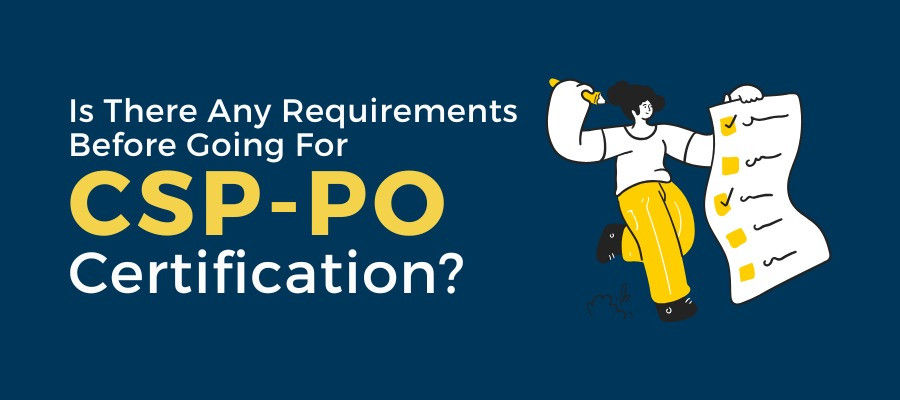Is There Any Requirements Before Going For CSP-PO Certification?

If you aim to become a Certified Scrum Professional Product Owner (CSP-PO), you're likely serious about advancing your Product Owner skills. The CSP-PO certification course isn’t just another step up in the Scrum world—it’s a commitment to mastering advanced strategies and refining your approach as a Product Owner.
So, what do you need to qualify? Let’s break down each requirement before earning this prestigious certification.
1. You Must Hold an A-CSPO Certification
To pursue CSP-PO certification, you must hold an Advanced Certified Scrum Product Owner (A-CSPO) certification from Scrum Alliance. Why? The A-CSPO builds on the foundational knowledge you gained in CSPO and expands your capabilities in backlog management, stakeholder collaboration, and vision-setting.
In short, CSP-PO training in India or elsewhere assumes you have experience with the intermediate challenges of the Product Owner role. With A-CSPO, you’re ready to handle more complexity, but Certified Scrum Professional CSP-PO will prepare you for leadership.
If your A-CSPO is expired, no worries—both your A-CSPO and CSPO certifications renew automatically once you earn CSP-PO. This makes it an ideal opportunity to refresh your credentials while progressing to an advanced level.
2. Attend a CSP-PO Educational Offering
One of the core requirements is to attend an approved CSP-PO certification course offered by a certified Scrum Alliance trainer to learn:
- Implementing strategy and purpose for the product
- Testing product assumptions with high-level techniques
- Advanced product backlog management
You'll dive into strategic areas through this CSP-PO training in India or wherever you choose to take it. This isn’t about covering essential Product Owner duties. Instead, it’s about handling more complex, strategic challenges and learning techniques that create value for customers and stakeholders.
3. Complete All Course Components
To officially qualify, you must complete every part of the CSP-PO certification course. Each course component is designed to enhance your skills and help you apply advanced practices immediately.
Why is this important? Unlike other certifications that may only require course attendance, Certified Scrum Professional CSP-PO asks you to show absolute mastery. This means participating fully, completing assignments, and demonstrating your understanding of advanced concepts.
4. Accept the CSP-PO License Agreement
Another requirement is to accept the CSP-PO License Agreement. This agreement is a formal acknowledgment of Scrum Alliance’s standards and expectations. By signing, you commit to upholding the values and practices of Scrum Alliance and the professional standards associated with Certified Scrum Professional Product Owner.
It’s a step toward becoming part of the global Scrum community. The License Agreement also reflects the importance Scrum Alliance places on ethical practices, so as a CSP-PO, you’ll represent these values in your work.
5. Validate Work Experience as a Product Owner
Now, this one’s big. To qualify for CSP-PO, you must have at least 24 months of experience as a Product Owner within the past five years. This isn’t an entry-level certification; it’s for those who’ve been in the trenches and understand the actual demands of the role.
Why is this experience critical? CSP-PO certification is designed for professionals ready to move beyond day-to-day tasks and embrace a strategic role. Your experience gives you the foundation to tackle the advanced concepts you’ll learn.
6. Renew Your CSP-PO Certification Every Two Years
Once you’ve achieved Certified Scrum Professional (CSP-PO) status, maintaining it requires ongoing learning. You must earn Scrum Education Units (SEUs) to renew the certification every two years.
Why? Scrum, Agile, and the technology landscape are constantly evolving. Keeping your certification current means you’re current on the latest best practices. It also shows your commitment to continuous learning and adaptation, which is vital in Agile environments.
SEUs can be earned through various activities, including attending Agile conferences, writing articles on Agile topics, or participating in community events. This ensures that your CSP-PO training in India doesn’t end with the course but evolves as your career does.
Final Thoughts On Taking The CSP-PO Journey
Becoming a Certified Scrum Professional Product Owner requires effort, experience, and a drive to improve continuously. From holding the A-CSPO certification to validating your work experience, each requirement ensures that CSP-POs have the advanced skills they need to succeed in complex Agile environments.
Ready to start? Consider exploring CSP-PO certification course options and choosing a training provider like PremierAgile to get expert guidance. The CSP-PO journey is challenging but rewarding, positioning you as a strategic leader in the Scrum world.
Reference:
https://www.scrumalliance.org/get-certified/product-owner-track/certified-scrum-professional-product-owner




